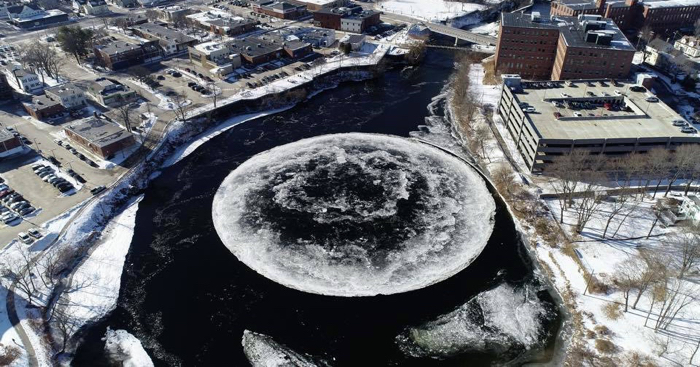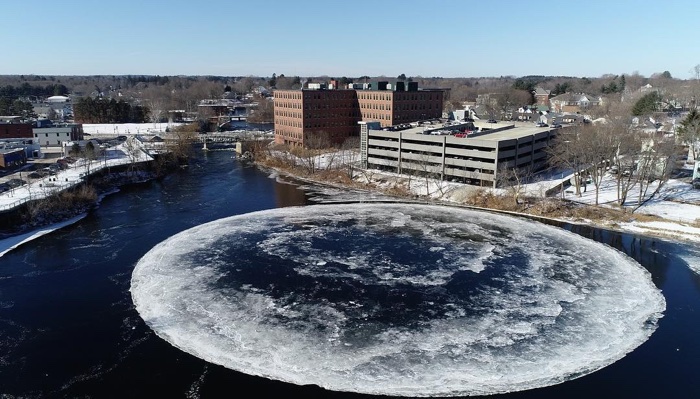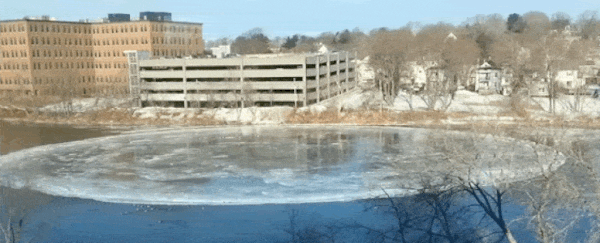It's been compared to crop circles, or the strange handiwork of aliens. Others say it looks like the Moon, if it somehow materialised in the chilly waters of the Presumpscot River.
But this massive churning formation in the city of Westbrook, Maine isn't evidence of something from outer space, but rather a bizarre and brilliant example of a natural terrestrial phenomenon called an ice disc.
These strange, spinning spectacles are incredibly rare sightings, but even so, this one – estimated to measure about 90 metres (300 ft) across – is a giant amongst its little-seen kind.
 (City of Westbrook/Facebook)
(City of Westbrook/Facebook)
"It might be a world-record size, if anybody were keeping track," Caltech physicist Kenneth G. Libbrecht told The New York Times.
The eerie, icy formation, which steadily rotates in a counter-clockwise direction, was first noticed by Westbrook citizens on Monday.
In fairness, though, by that point, a number of the city's animal residents had already flocked to the unlikely new attraction.
"There were ducks sitting on it," local man Rob Mitchell, who alerted city authorities to the strange spinning disc, told the Portland Press Herald.
"The ducks were rotating on this big Lazy Susan. It was a big duck-go-round."
 (City of Westbrook/Facebook)
(City of Westbrook/Facebook)
Ice discs have intrigued scientists since at least the late 19th century, when a reader of Scientific American described "a revolving ice cake" spotted on the Mianus River near Bedford, New York.
"I inclose a rough drawing, which will give an idea of this curious formation," J.M. Bates wrote to the publication in 1895.
Since then, the conventional explanation for the unusual rotation is the swirling motion of river eddies, which keep ice formations on frigid rivers in a state of perpetual spinning.
"Since the water in the eddy is flowing more slowly than the main current, it's more likely to freeze, creating the icy disc," experimental physicist John Huth from Harvard University explained to The Boston Globe.
"The icy disc retains the rotation of the eddy, as it's caught in it."
Meanwhile, a combination of melting and shearing effects (impacts against the rocky shoreline or other ice, for instance) continually shape the edges of the disc, keeping it circular.
But that's not all that's going on with ice discs.
A 2016 experiment recreated the natural phenomenon in the lab – where no eddies happened to be swirling – and concluded that something else had to be contributing to the spin.
In that study, researchers discovered, as water melts off the ice disc and sinks below it, it generates a "vertical vortex" under the disc that induces the ice block above to rotate.
In the case of the Westbrook phenomenon, it all adds up to an amazing demonstration of physics in the natural environment.
Or, in other words, "big disk energy", as one wit on Twitter put it.
And it makes for some very happy ducks.
Honestly the best part of this ice disk are the ducks taking a ride on it 😂❤️🦆 pic.twitter.com/0Lz9qlUHaW
— Taylor Gleason (@TaylorGleason__) January 15, 2019
Those birds aren't the only winners.
The city of Westbrook is busily exploiting tourism opportunities afforded by interest in the massive churning spectacle, at least while it lasts.
"The mysterious Ice Disk is still spinning today in Westbrook," local authorities wrote in a Facebook post.
"Come down to the River Walk, take a selfie, and grab some lunch at one of our awesome nearby restaurants!"
